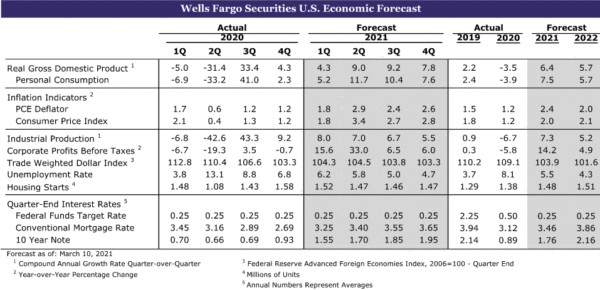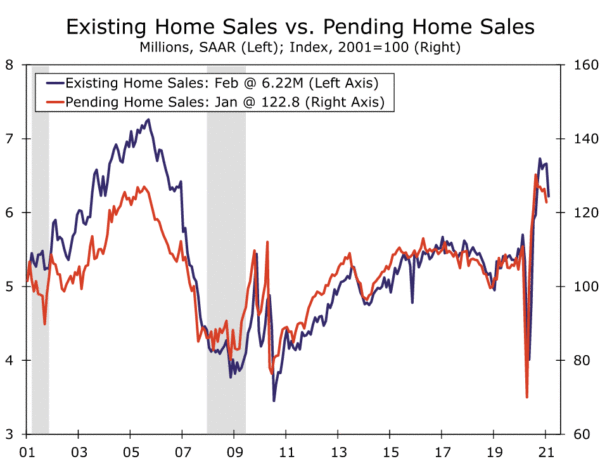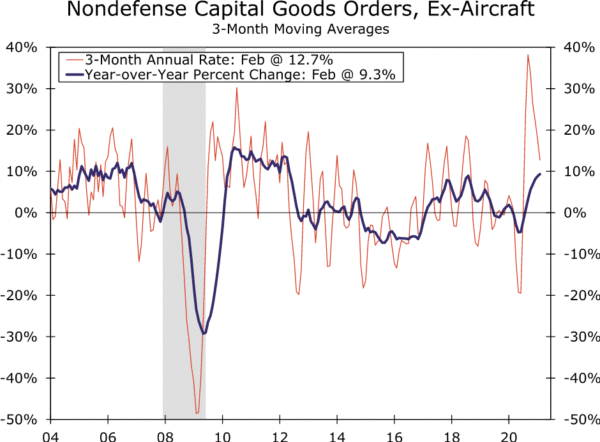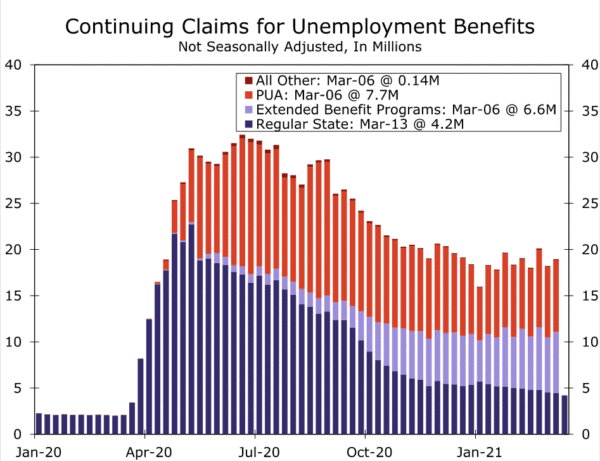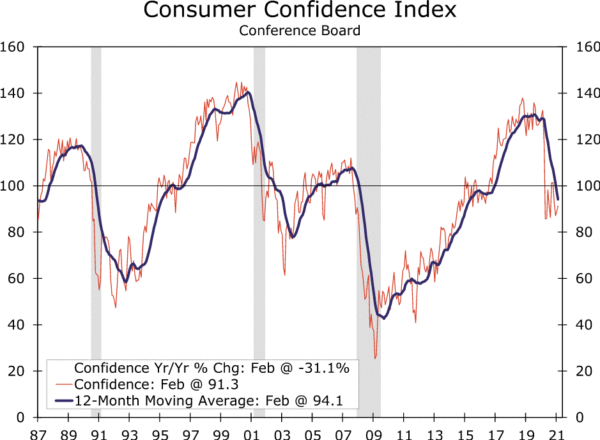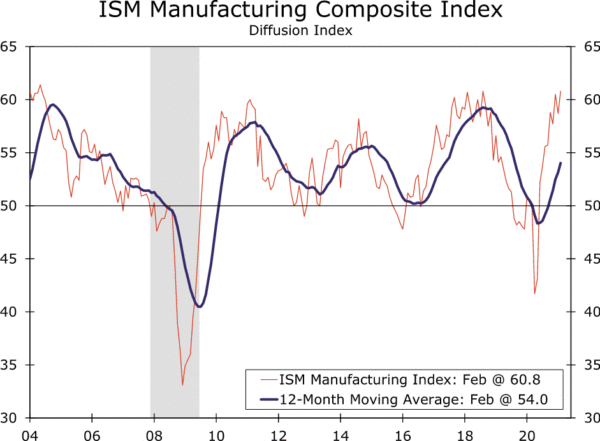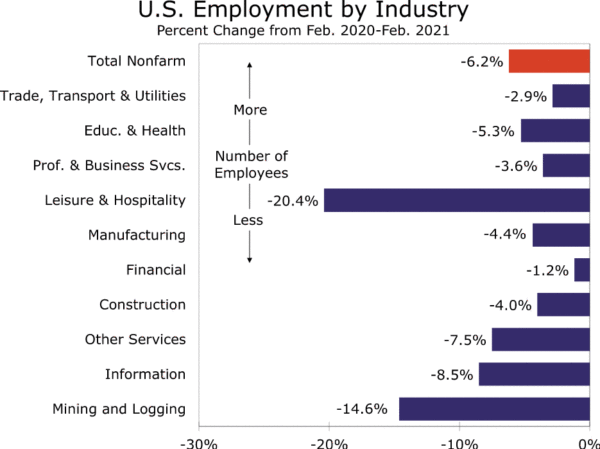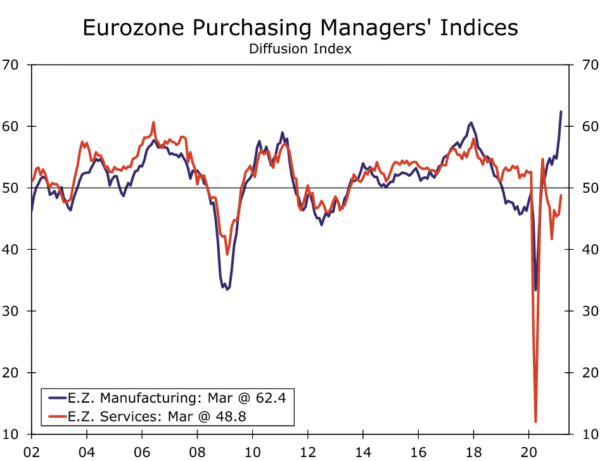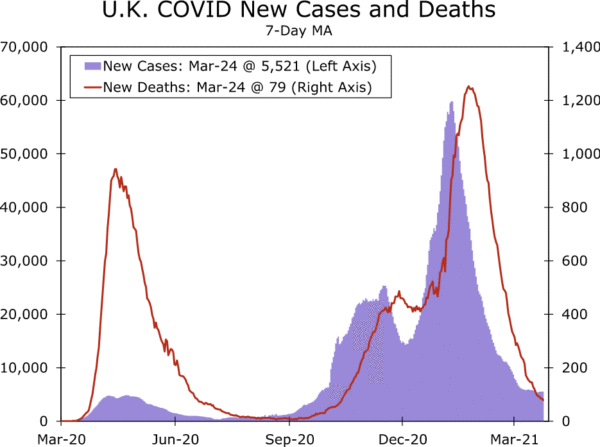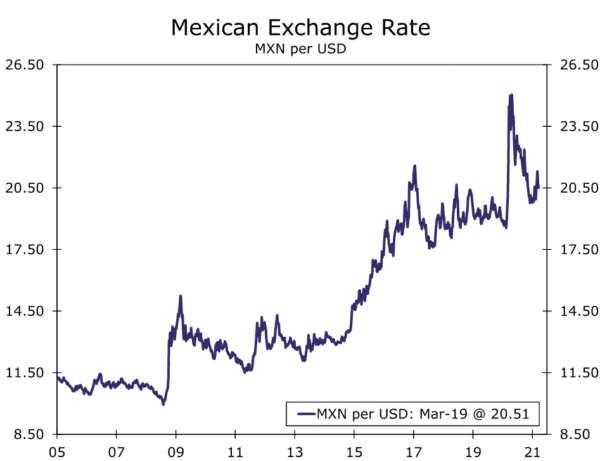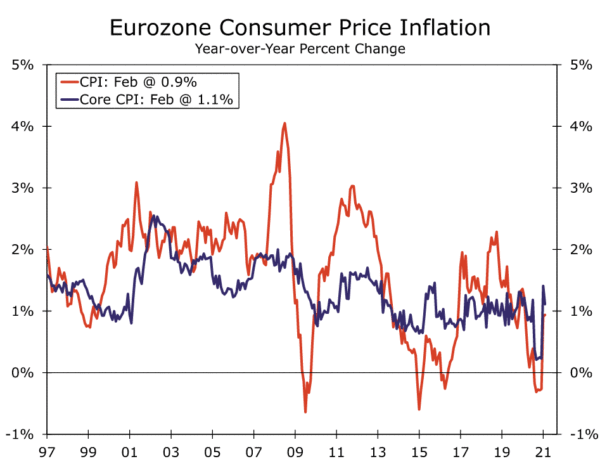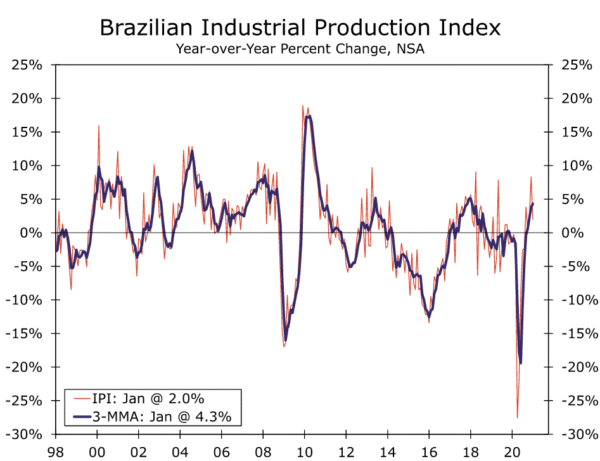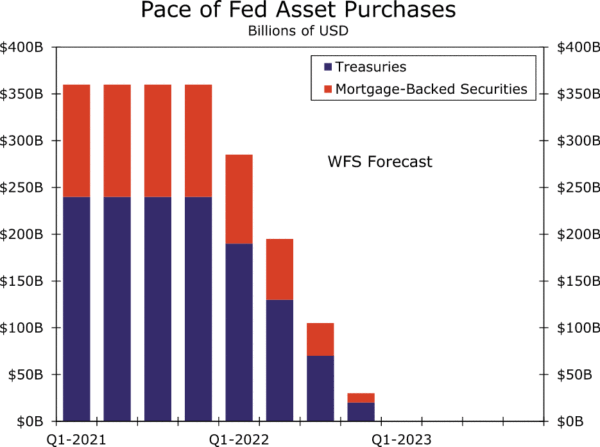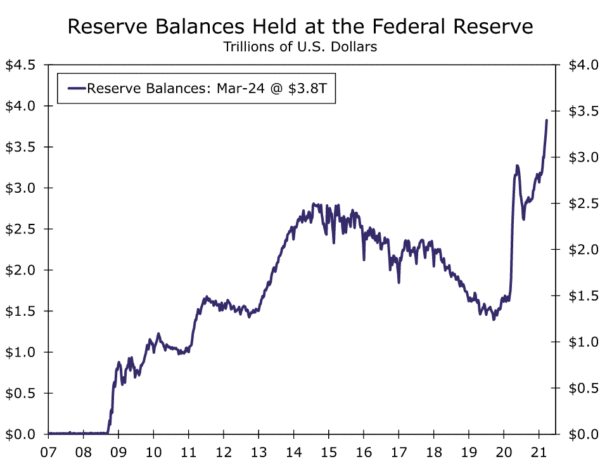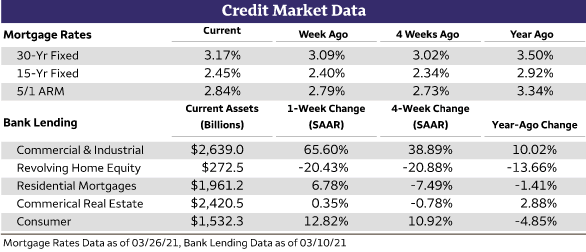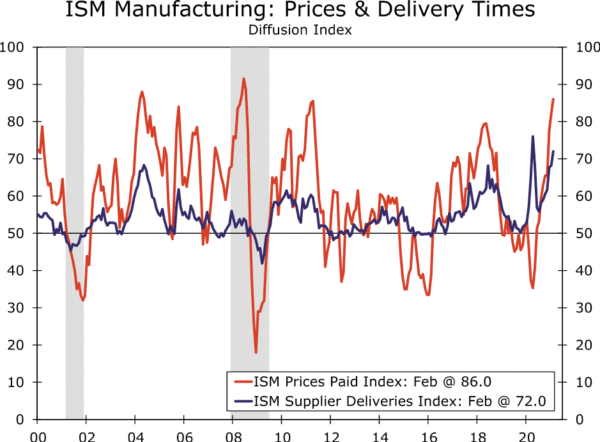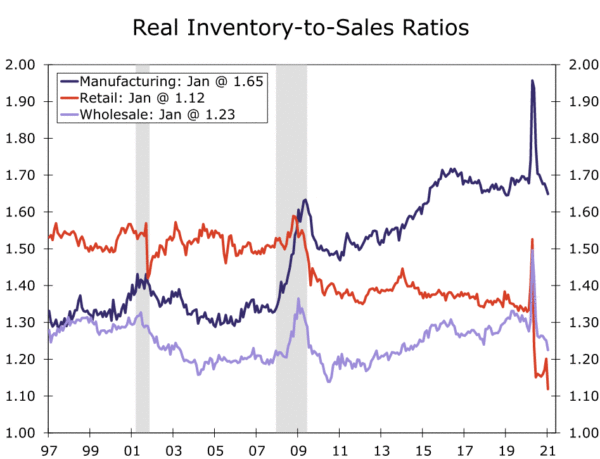U.S. Review
Softer Economic Data Do Not Signal a Change in Underlying Momentum
- This week’s larger-than-expected declines in durable goods orders as well as new and existing home sales do not signal a shift in the economy’s strong underlying momentum. Some payback in home sales was widely expected and monthly data are particularly volatile in the normally slow winter months. Survey data for the factory sector suggest that production and employment are still in the early stages of revving back up, and the latest weekly first-time unemployment claims fell to the lowest level since they spiked, following the onset of the pandemic.
International Review
Signs of Life in Europe, but Most Countries Still Chasing the United States
- The preliminary March PMIs for the Eurozone showed a vibrant manufacturing sector that is only partially offsetting a service sector that remains largely stuck in the mud. The U.K. economic outlook is starting to brighten, while the Bank of Mexico decided to keep its policy rate on hold during a highly anticipated meeting.
Interest Rate Watch
Short-Term and Long-Term U.S. Yields Diverge
- Rising long-term Treasury yields took a breather this week. Accelerating real GDP, employment and prices, as well as an eventual taper of Federal Reserve asset purchases in 2022, should keep longer-dated Treasury yields grinding higher over the course of the year.
Topic of the Week
The Hits to Global Supply Chains Keep Coming
- The extended blockage of the Suez Canal this week by a container ship is yet another challenge for global supply chains already strained by the pandemic. Inventories were already tight before the latest disruption, and with delays coming at a cost, the inflationary pressure stemming from the goods sector is not likely to go away soon.
U.S. Review
Don’t Sweat February’s Pullback in Home Sales
Both existing and new home sales fell more than expected during February, with existing sales falling 6.6% and new home sales tumbling 18.2%. While the declines were larger than expected, the data were widely expected to decline in February, following the surge in sales and home prices seen during the second half of last year. Advance data on home sales, most notably pending home sales and mortgage purchase applications, have been trending lower for some time and actual sales were bound to catch up at some point. The harsh winter weather, which affected the middle of the country in February, also likely added to the drop in new home sales, as Texas is the nation’s top new home market.
The moderation in home sales occurred before mortgage rates moved higher, which has raised some concerns about the key spring selling season. On our housing outlook call this week, we noted that the beneficial impacts of stronger economic growth, particularly the roughly 6.8 million jobs we expect to be added back this year, will more than offset the impact from modestly higher mortgage rates. Home sales have been disproportionately skewed toward the upper end of the market. Employment among higher-income workers did not fall as hard during the pandemic and recovered much faster. This year will see economic growth broaden and strengthen, which should bring out more home buyers and sellers.
Manufacturing Has Strong Momentum, but the Restart Has Some Hiccups
Advance orders for durable goods declined 1.1% in February, with modest declines spread among most major industry categories. Orders for vehicles and parts plunged 8.7% during the month and more than accounted for the overall drop in orders, but even after excluding the volatile transportation sector, orders fell 0.9%. Core capital goods orders, which strips transportation and defense, fell 0.7%. That drop follows a long string of increases and orders are up at a 12.7% annual rate over the past three months.
Shipments fell 3.5% in February. Shipments were likely affected by February’s harsh winter weather as well as supply chain bottlenecks, which continued into March. Stripping out aircraft and defense, core capital goods shipments, which are a good proxy for business fixed investment, fell 1.0% in February, but remain up at a 13.4% annual rate over the past three months. Some moderation in business investment was expected in the first quarter and that appears to be playing out.
While the orders data came in on the soft side, the various surveys that follow manufacturing all continue to show considerable strength and point to widespread production and shipping bottlenecks. The Richmond Fed manufacturing index rose three points to 17 in March, and the preliminary March reading of the March Markit US Manufacturing PMI rose slightly to a robust 59.
Layoffs Continue to Trend Lower
Initial claims for unemployment insurance broke below 700,000 for the first time since spiking at the onset of the pandemic. While still elevated, the continued slide in claims to 684,000 shows that layoffs are continuing to trend lower. A year ago, initial weekly filings shot up to 3.31 million, almost five times the level of the worst week of the Great Recession.
The drop in COVID cases since the start of the year, continued rise in vaccinations and recent fiscal stimulus should help broaden the employment recovery to the millions of people, who are suffering from spells of long-term unemployment. About 4.2 million individuals continue to collect regular state unemployment benefits, while another 6.6 million are collecting extended benefits. On top of that, another 7.7 million continue to collect from the Pandemic Unemployment Assistance (PUA) program. Many of these long-term unemployed were displaced from jobs in high-contact parts of the economy, which are poised to recover this spring and summer as the economy re-opens.
U.S. Outlook
Consumer Confidence • Tuesday
In recent weeks and months, forward-looking expectations for economic growth have brightened substantially. This is due in part to progress in the ongoing struggle against the pandemic with case counts falling on trend and as millions of Americans now receive vaccination shots on a daily basis. It also has to do with generous fiscal policy measures, which can underpin spending once some semblance of normality returns to the service sector.
So far, consumers’ expectations have been more measured than those of economic forecasters. The fact that February came with most of the country blanketed in snow amid widespread power outages goes a long way toward explaining why the rebound in consumer confidence in February was only modest. The weather improved in March though, and so did the financial situation of many households across the country as $1,400 stimulus checks and automatic deposits began to hit bank accounts, which should be supportive of a pickup in consumer confidence during the month.
- Previous: 91.3
- Wells Fargo: 97.7
- Consensus: 96.0
ISM Manufacturing Index • Thursday
The ISM manufacturing survey in February rose to its highest level in two years. The rebound in the factory sector is limited mostly by supply chain constraints, which suggest an uptick in supplier deliveries could lift the headline ISM even higher. Another signal that ISM could come in even hotter in March is the fact that last week we saw the strongest print for Philly Fed business outlook survey since the early 1970s. Other regional PMIs, like the surveys conducted by regional Fed offices in Richmond & Kansas City, were also higher. Inventories might be a drag and offset some of the potential boost of supplier deliveries.
Taken together, we are looking for an above-consensus number of 63.0 when this bellwether for the manufacturing sector prints on Thursday.
- Previous: 60.8
- Wells Fargo: 63.0
- Consensus: 61.0
Nonfarm Payrolls • Friday
While many parts of the economy have rebounded swiftly, the labor market has been slower to get back on its feet. During his testimony before the Senate this week, Fed Chairman Jay Powell responded to a question about the fact that the Fed’s own forecast showed only an incremental decline in the unemployment rate. He explained how a wave of hiring later this year would likely result in a rise in the participation rate as discouraged workers were drawn back into the labor force.
After the sector was devastated by the pandemic, leisure & hospitality will likely be the biggest driver of job growth this year, and we suspect we may see the first glimpse of that when the March jobs number hits the wire on Friday morning. In fact, we are penciling in a 675K jump in payrolls for the month, and expect to see the jobless rate dip to 6.0%. It may be early yet for the job growth to lure more people back into the labor force, even though we agree with the Fed that strong job growth might be accompanied by a comparatively steady decline in the unemployment rate.
- Previous: 379K
- Wells Fargo: 675K
- Consensus: 628K
International Review
Signs of Life in Europe, but Most Countries Still Chasing the United States
The preliminary March PMIs for the Eurozone showed a vibrant manufacturing sector that is only partially offsetting a service sector, which remains largely stuck in the mud. The manufacturing PMI climbed 4.5 points to 62.4 in March, the highest reading in at least 20 years (chart to the right). In contrast, the service sector PMI rose 3.1 points to 48.8, but it remained below 50 (the demarcation between expansion and contraction) for the seventh consecutive month. The composite PMI rose to 52.5, the first reading above 50 since October 2020.
In contrast to the United Kingdom and United States, most of continental Europe has had a slow vaccine rollout. The United Kingdom has administered about 45 doses per 100 people, while the United States has completed about 40 doses per 100 people. In contrast, France, Germany and Italy have each administered about 14 doses per 100 people. Perhaps unsurprisingly, Europe has had to keep tighter restrictions in place to keep COVID in check. We look for Eurozone real GDP to contract at a 4.9% annualized pace in Q1-2021. If realized, this would put Eurozone year-over-year real GDP growth at -2.4% in Q1-2021, well shy of the roughly flat growth seen in the United States over the same period. It will likely be another month or two before better weather and more vaccines permit a more widespread re-opening and economic acceleration in Europe.
As discussed earlier, the United Kingdom is well ahead of most countries on the vaccination front, and new COVID cases are currently the lowest they have been since early last fall (chart to the right). The U.K. government has announced plans to steadily lift restrictions over the next few months, and its announced fiscal support should help the economy weather the storm in the interim.
While the U.K. economy is far from firing on all cylinders, recent economic figures have generally delivered favorable surprises. In January, when the latest round of COVID-related restrictions were near their most stringent, GDP fell 2.9% month-over-month, much less than the expected decline of almost 5%. This week, the March PMIs offered additional evidence that the worst is behind the U.K. economy. The March manufacturing PMI rose to 57.9, while the services PMI rose to 56.8, the first time the services PMI has been above the breakeven 50 level since October last year. Given the more positive recent signals, we have lifted our U.K. GDP growth outlook for 2021 modestly, to 5.5% from 4.5% in late February. You can read more about our latest changes to our international economic outlook here.
The Bank of Mexico met this week and faced a confluence of headwinds that left some financial market participants unsure of what the central bank would do. On the one hand, the Mexican economy is still struggling to recover from COVID. However, rising U.S. yields have put pressure on the Mexican peso (as well as many other emerging market economies), and both headline and core inflation are about a percentage point above the central bank’s target (chart to the right). The Bank of Mexico decided to forego a rate cut and keep rates on hold this week, implicitly making it clear that monetary policymakers are concerned about the possible repercussions from above-target inflation and peso depreciation.
Perhaps monetary policymakers in Mexico are taking comfort in the consumer-driven growth in the United States, which can benefit the Mexican peso. Given strong trade linkages between the U.S. and Mexico, strong consumer demand can improve Mexico’s export sector and facilitate the local economic recovery. Recently, we upgraded our Mexico GDP forecast to reflect these dynamics. A less dovish central bank should support the currency in the short term, while a global economic recovery and improved sentiment toward emerging market currencies can help the peso strengthen over the long term.
International Outlook
Eurozone CPI • Wednesday
Eurozone inflation, as measured by the consumer price index (CPI), jumped to start the year, with headline inflation leaping to 0.9% year-over-year in January from -0.3% in December. Core inflation also saw a large year-over-year increase, rising to 1.4% in January from 0.2% in December. These jumps were more driven by quirks in the data (such as an increase in Germany’s value-added tax) rather than underlying price acceleration, and core inflation receded back to 1.1% in February. Base effects and higher energy prices should drive both headline and core inflation higher over the next few months, but through the noise, we expect underlying core inflation to remain short of the European Central Bank’s target for “below, but close to, 2%” inflation. With inflation soft and the Eurozone economy still searching for a bottom, the European Central Bank will likely maintain a dovish bias for the foreseeable future.
- Previous: 0.9%
- Consensus: 1.3% (Headline, Year-over-Year)
Brazil Industrial Production • Thursday
Brazil’s near-term economic outlook is challenged due to a significant deterioration in the public health situation in the country. New COVID cases and fatalities are at historic highs, hospitals are at capacity and restrictions in major cities have been reimposed. Brazil recently became only the second country with more than 300,000 deaths from COVID. Fiscal stimulus can offset some of these issues, but Brazil’s ability to float its economy through borrowing is more constrained than many advanced economies. Unlike the Federal Reserve or the European Central Bank, the Central Bank of Brazil recently hiked rates 75 bps to defend its currency and keep inflation in check. How much economic damage will higher COVID cases, more restrictions and tighter monetary policy do? We have revised our 2021 GDP growth forecast for Brazil to 4.0% from 4.5%, and we will be looking for evidence in the hard data over the next month or two for signs that the slowdown could be more pronounced.
- Previous: 2.0%
- Consensus: 1.5% (Year-over-Year)
Interest Rate Watch
Short-Term and Long-Term U.S. Yields Diverge
The yield on the 10-year Treasury security took a breather this week after reaching a one-year high of 1.74% on Friday, March 19. Our forecast coming into 2021 was for longer-term yields to rise throughout the year as the economic recovery progressed and markets digested a significant amount of longer-dated Treasury issuance needed to fund the federal budget deficit. The pace of the upward move since the beginning of February has been sharper than we were expecting, but this week some consolidation has taken place, with the 10-year Treasury yield at roughly 1.6% as of this writing.
As we look to the rest of the year, we anticipate that longer-term Treasury yields will continue rising: Our year-end target for the 10-year yield is about 2%. We look for a significant acceleration in real GDP and employment starting in Q2 that should carry through the fall, and while inflation data over the next few months will likely be noisy due to quirky base effects from a year ago, the underlying trend should be for faster price growth. By the fall, we also expect financial markets to begin more seriously contemplating a Federal Reserve tapering of its asset purchases. It is our expectation that the Federal Reserve will continue purchasing Treasury securities and mortgage-backed securities (MBS) at the current $80B/$40B pace through the end of this year. We do not expect the composition of the purchases to change over this time period. By the start of 2022, however, we expect a gradual tapering of purchases to begin. More specifically, we look for the Federal Reserve to cut its $80 billion in Treasury purchases/$40 billion in MBS purchases by $10 billion and $5 billion, respectively, at each FOMC meeting such that purchases are completed by November 2022 (see chart).
Short-Term Rates Anchored for Now
While longer-term Treasury yields have been on the rise, short-term interest rates have gone nowhere fast. The Secured Overnight Financing Rate (SOFR) and T-bill yields are pinned near zero, and the two-year Treasury yield is basically unchanged on the year at 0.14%. This is in line with our forecast; we do not expect the Federal Reserve to hike the fed funds rate for at least the next 24 months, which should keep short-term interest rates around current levels. Furthermore, the Fed’s continued asset purchases, as well as the recently passed American Rescue Plan (ARP), have added a tremendous amount of cash to the financial system, much of which is putting downward pressure on short-term interest rates. Bank reserves held at the Fed are on an upward trajectory (chart to the right), and we doubt that will change anytime soon. Thus, for at least the next couple quarters, we believe any major moves in yields are likely to occur past the two-year point on the Treasury curve.
Topic of the Week
And the Disruptions to Global Supply Chains Keep Coming
The blockage of the Suez Canal by a container ship this week is yet another setback to global supply chains. Supply chains have been stretched to the brink by COVID and have yet to recover from closures early on in the pandemic that have been coupled with a sudden surge in goods spending. That dynamic has been most evident in the semiconductor shortage, which we discussed in this section last week. But, strains extend beyond semiconductors. Staffing challenges due to health concerns and childcare issues have held back production for months. Transportation networks are struggling to meet demand, leading to delays and higher costs. More recently, severe winter in the United States sent some manufacturers temporarily offline. The delays are piling up. Barring the peak of shutdowns last April, the ISM supplier delivery index hit more than a 40-year high in February.
Where are strains most acute? Inventories as measured by the Bureau of Economic Analysis include input materials, products partially completed and finished goods ready to be sold. The collapse in the real retail I-S ratio is evidence of finished products flying off the shelves. The more stubborn ratio for the manufacturing and wholesale sector is indicative of bottlenecks further back in the pipeline. It only takes one missing part at manufacturers to delay production. Securing transportation has also become an issue, with containers in short supply. Longer transit times, which force companies to hold inventories on their books longer, have also contributed to the more modest decline in the I-S ratios for manufacturers and wholesalers when compared to retailers.
Within the manufacturing sector, 17 of 22 major industries report I-S ratios below their 2015-2019 average. The steepest declines have occurred in computer & electronics and motor vehicles, which is not surprising given the industries’ reliance on semiconductors. But, other industries like metals, machinery, textiles and chemicals were already seeing lower I-S ratios before February’s disruptive weather and the disruption to the Suez shipping channel.
As we have said before, the biggest issue for manufacturers right now is getting the stuff they need, including materials, shipping space and workers. That challenge is now only more complicated by the extended blockage of the Suez Canal. The delays come with a cost, and with inventories already tight, the inflationary pressure stemming from the goods sector is unlikely to go away anytime soon.




